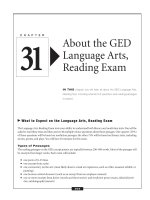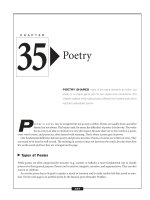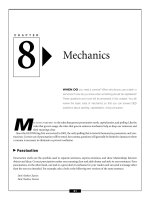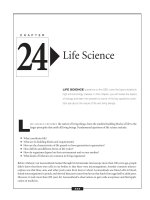About the GED Mathematics Exam
Bạn đang xem bản rút gọn của tài liệu. Xem và tải ngay bản đầy đủ của tài liệu tại đây (412.22 KB, 20 trang )
What to Expect on the GED Mathematics Exam
The GED Mathematics Exam measures your understanding of the mathematical knowledge needed in everyday
life. The questions are based on information presented in words, diagrams, charts, graphs, and pictures. In addi-
tion to testing your math skills, you will also be asked to demonstrate your problem-solving skills. Examples of
some of the skills needed for the mathematical portion of the GED are:
■
understanding the question
■
organizing data and identifying important information
■
selecting problem-solving strategies
■
knowing when to use appropriate mathematical operations
■
setting up problems and estimating
■
computing the exact, correct answer
■
reflecting on the problem to ensure the answer you choose is reasonable
This section will give you lots of practice in the basic math skills that you use every day as well as crucial
problem-solving strategies.
CHAPTER
About the GED
Mathematics
Exam
IN THIS chapter, you will learn all about the GED Mathematics
Exam, including the number and type of questions, the topics and
skills that will be tested, guidelines for the use of calculators, and
recent changes in the test.
40
385
The GED Mathematics Test is given in two separate
sections. The first section permits the use of a calculator;
the second does not. The time limit for the GED is 90
minutes, meaning that you have 45 minutes to complete
each section. The sections are timed separately but
weighted equally. This means that you must complete
both sections in one testing session to receive a passing
grade. If only one section is completed, the entire test
must be retaken.
The test contains 40 multiple-choice questions and
ten gridded-response questions for a total of 50 ques-
tions overall. Multiple-choice questions give you several
answers to choose from and gridded-response questions
ask you to come up with the answer yourself. Each
multiple-choice question has five answer choices, a
through e. Gridded response questions use a standard
grid or a coordinate plane grid. (The guidelines for
entering a gridded-response question will be covered
later in this section.)
Test Topics
The math section of the GED tests you on the following
subjects:
■
measurement and geometry
■
algebra, functions, and patterns
■
number operations and number sense
■
data analysis, statistics, and probability
Each of these subjects is detailed in this section along
with tips and strategies for solving them. In addition, 100
practice problems and their solutions are given at the end
of the subject lessons.
Using Calculators
The GED Mathematics Test is given in two separate
booklets, Part I and Part II. The use of calculators is per-
mitted on Part I only. You will not be allowed to use your
own. The testing facility will provide a calculator for you.
The calculator that will be used is the Casio fx-260. It is
important for you to become familiar with this calcula-
tor as well as how to use it. Use a calculator only when it
will save you time or improve your accuracy.
Formula Page
A page with a list of common formulas is provided with
all test forms. You are allowed to use this page when you
are taking the test. It is necessary for you to become
familiar with the formula page and to understand when
and how to use each formula. An example of the formula
page is on page 388 of this book.
Gridded-Response and Set-Up
Questions
There are ten non-multiple-choice questions in the math
portion of the GED. These questions require you to find
an answer and to fill in circles on a grid or on a coordi-
nate axis.
S
TANDARD
G
RID
-
IN
Q
UESTIONS
When you are given a question with a grid like the one
below, keep these guidelines in mind:
■
First, write your answer in the blank boxes at the
top of the grid. This will help keep you organized
as you “grid in” the bubbles and ensure that you
fill them out correctly.
■
You can start in any column, but leave enough
columns for your whole answer.
■
You do not have to use all of the columns. If your
answer only takes up two or three columns, leave
the others blank.
■
You can write your answer by using either frac-
tions or decimals. For example, if your answer
is
ᎏ
1
4
ᎏ
, you can enter it either as a fraction or as a
decimal, .25.
The slash “/” is used to signify the fraction bar of the
fraction. The numerator should be bubbled to the left of
the fraction bar and the denominator should be bubbled
in to the right. See the example on the next page.
–
ABOUT THE GED MATHEMATICS EXAM
–
386
■
When your answer is a mixed number, it must be
represented on the standard grid in the form of
an improper fraction. For example, for the
answer 1
ᎏ
1
4
ᎏ
, grid in
ᎏ
5
4
ᎏ
.
■
When you are asked to plot a point on a coordi-
nate grid like the one below, simply fill in the
bubble where the point should appear.
S
ET
-U
P
Q
UESTIONS
These questions measure your ability to recognize the
correct procedure for solving a problem. They ask you to
choose an expression that represents how to “set up” the
problem rather than asking you to choose the correct
solution. About 25 percent of the questions on the GED
Mathematics Test are set-up questions.
Example: Samantha makes $24,000 per year at a new
job. Which expression below shows how much
she earns per month?
a. $24,000 + 12
b. $24,000 − 12
c. $24,000 × 12
d. $24,000 ÷ 12
e. 12 ÷ $24,000
Answer: d. You know that there are 12 months in a
year. To find Samantha’s monthly income, you
would divide the total ($24,000) by the number
of months (12). Option e is incorrect because it
means 12 is divided by $24,000.
Graphics
Many questions on the GED Mathematics Test use
diagrams, pie charts, graphs, tables, and other visual
stimuli as references. Sometimes, more than one of these
questions will be grouped under a single graphic. Do not
let this confuse you. Learn to recognize question sets by
reading both the questions and the directions carefully.
What’s New for the GED?
The structure of the GED Mathematics Test, revised in
2002, ensures that no more than two questions should
include “not enough information is given” as a correct
answer choice. Given this fact, it is important for you to
pay attention to how many times you select this answer
choice. If you find yourself selecting the “not enough
information is given” for the third time, be sure to check
the other questions for which you have selected this
choice because one of them must be incorrect.
The current GED has an increased focus on “math in
everyday life.” This is emphasized by allowing the use of
a calculator on Part I as well as by an increased empha-
sis on data analysis and statistics. As a result, gridded-
response questions and item sets are more common. The
number of item sets varies.
1
2
−3
4
−5
−6
0
1
−2
3
4
5
6
−1
2 3
−4
5
−6
−1
−2−3−4
−5
6
1
2
3
4
5
6
7
8
9
•
1
2
3
4
5
6
7
8
9
0
•
/
1
2
3
4
55
6
7
8
9
0
/
1
3
4
6
7
88
9
0
•
/
1
2
3
4
6
7
9
0
•
2
.
5
1
2
3
4
5
6
7
8
9
•
1
2
3
4
5
6
7
8
9
0
•
/
2
3
4
5
6
7
8
9
0
•
/
1
2
3
4
5
6
7
8
9
0
•
1
2
3
5
6
7
8
9
0
•
1 / 4
–
ABOUT THE GED MATHEMATICS EXAM
–
387
Area of a:
square Area = side
2
rectangle Area = length ϫ width
parallelogram Area = base ϫ height
triangle Area =
ᎏ
1
2
ᎏ
ϫ base ϫ height
trapezoid Area =
ᎏ
1
2
ᎏ
ϫ (base
1
+ base
2
) ϫ height
circle Area = π ϫ radius
2
; π is approximately equal to 3.14
Perimeter of a:
square Perimeter = 4 ϫ side
rectangle Perimeter = 2 ϫ length + 2 ϫ width
triangle Perimeter = side
1
+ side
2
+ side
3
Circumference of a circle Circumference = π ϫ diameter; π is approximately equal to 3.14
Volume of a:
cube Volume = edge
3
rectangular solid Volume = length ϫ width ϫ height
square pyramid Volume =
ᎏ
1
3
ᎏ
ϫ (base edge)
2
ϫ height
cylinder π ϫ radius
2
ϫ height π is approximately equal to 3.14
cone Volume =
ᎏ
1
3
ᎏ
ϫ π ϫ radius
2
ϫ height; π is approximately equal to 3.14
Coordinate Geometry distance between points = ͙(x
2
– x
ෆ
1
)
2
+ (y
ෆ
2
– y
1
)
ෆ
2
ෆ
; (x
1
,y
1
) and (x
2
,y
2
) are two points
in a plane
slope of a line =
ᎏ
y
x
2
2
–
–
y
x
1
1
ᎏ
; (x
1
,y
1
) and (x
2
,y
2
) are two points on the line
Pythagorean Relationship a
2
+ b
2
= c
2
; a and b are legs and c is the hypotenuse of a right triangle
Measures of mean =
ᎏ
x
1
+ x
2
+
n
...+x
n
ᎏ
, where the x's are the values for which a mean is desired,
Central Tendency and n is the total number of values for x.
median = the middle value of an odd number of ordered scores, and halfway
between the two middle values of an even number of ordered scores.
Simple Interest interest = principal ϫ rate ϫ time
Distance distance = rate ϫ time
Total Cost total cost = (number of units) ϫ (price per unit)
Adapted from official GED materials.
388
Formulas
T
HE USE OF
measurement enables you to form a connection between mathematics and the real world.
To measure any object, assign a unit of measure. For instance, when a fish is caught, it is often weighed
in ounces and its length measured in inches. This lesson will help you become more familiar with the
types, conversions, and units of measurement.
Also required for the GED Mathematics Test is knowledge of fundamental, practical geometry. Geometry is the
study of shapes and the relationships among them. A comprehensive review of geometry vocabulary and con-
cepts, after this measurement lesson, will strengthen your grasp on geometry.
CHAPTER
Measurement
and Geometry
THE GED Mathematics Test emphasizes real-life applications of
math concepts, and this is especially true of questions about meas-
urement and geometry. This chapter will review the basics of meas-
urement systems used in the United States and other countries,
performing mathematical operations with units of measurement, and
the process of converting between different units. It will also review
geometry concepts you’ll need to know for the exam, such as prop-
erties of angles, lines, polygons, triangles, and circles, as well as the
formulas for area, volume, and perimeter.
41
389
Types of Measurements
The types of measurements used most frequently in the
United States are listed below:
Units of Length
12 inches (in.) = 1 foot (ft.)
3 feet = 36 inches = 1 yard (yd.)
5,280 feet = 1,760 yards = 1 mile (mi.)
Units of Volume
8 ounces* (oz.) = 1 cup (c.)
2 cups = 16 ounces = 1 pint (pt.)
2 pints = 4 cups = 32 ounces = 1 quart (qt.)
4 quarts = 8 pints = 16 cups = 128 ounces = 1 gallon
(gal.)
Units of Weight
16 ounces* (oz.) = 1 pound (lb.)
2,000 pounds = 1 ton (T.)
Units of Time
60 seconds (sec.) = 1 minute (min.)
60 minutes = 1 hour (hr.)
24 hours = 1 day
7 days = 1 week
52 weeks = 1 year (yr.)
12 months = 1 year
365 days = 1 year
*Notice that ounces are used to measure both the volume and
weight.
Converting Units
When performing mathematical operations, it is neces-
sary to convert units of measure to simplify a problem.
Units of measure are converted by using either multipli-
cation or division:
■
To change a larger unit to a smaller unit, simply
multiply the specific number of larger units by
the number of smaller units that makes up one of
the larger units.
For example, to find the number of inches in 5
feet, simply multiply 5, the number of larger units,
by 12, the number of inches in one foot:
5 feet = how many inches?
5 feet × 12 inches (the number of inches in a single
foot) = 60 inches
Therefore, there are 60 inches in 5 feet.
Try another:
Change 3.5 tons to pounds.
3.5 tons = how many pounds?
3.5 tons × 2,000 pounds (the number of pounds in
a single ton) = 6,500 pounds
Therefore, there are 6,500 pounds in 3.5 tons.
■
To change a smaller unit to a larger unit, simply
divide the specific number of smaller units by the
number of smaller units in only one of the larger
units.
For example, to find the number of pints in 64
ounces, simply divide 64, the smaller unit, by 16,
the number of ounces in one pint.
= 4 pints
Therefore, 64 ounces are equal to four pints.
Here is one more:
Change 24 ounces to pounds.
= 2 pounds
Therefore, 32 ounces are equal to two pounds.
Basic Operations with
Measurement
It will be necessary for you to review how to add, sub-
tract, multiply, and divide with measurement. The
mathematical rules needed for each of these operations
with measurement follow.
Addition with Measurements
To add measurements, follow these two steps:
1. Add like units.
2. Simplify the answer.
32 ounces
ᎏᎏ
16 ounces
64 ounces
ᎏᎏ
16 ounces
specific number of the smaller unit
ᎏᎏᎏᎏᎏ
the number of smaller units in one larger unit
–
MEASUREMENT AND GEOMETRY
–
390
Example: Add 4 pounds 5 ounces to 20 ounces.
4 lb. 5 oz. Be sure to add ounces to ounces.
+
20 oz.
4 lb. 25 oz. Because 25 ounces is more than 16
ounces (1 pound), simplify by
dividing by 16. Then add the 1
pound to the 4 pounds.
4 lb. + 25 oz.
1 lb.
4 lb. + 16ͤ25
ෆ
−16
9 oz.
4 pounds 25 ounces =
4 pounds + 1 pound 9 ounces =
5 pounds 9 ounces
Subtraction with Measurements
1. Subtract like units.
2. Regroup units when necessary.
3. Write the answer in simplest form.
For example, to subtract 6 pounds 2 ounces
from 9 pounds 10 ounces,
9 lb. 10 oz. Subtract ounces from ounces.
−
6 lb. 2 oz. Then, subtract pounds from pounds.
3 lb. 8 oz.
Sometimes, it is necessary to regroup units when
subtracting.
Example: Subtract 3 yards 2 feet from 5 yards 1
foot.
5
4
yd. 1
4
ft.
− 3 yd. 2 ft.
1 yd. 2 ft.
From 5 yards, regroup 1 yard to 3 feet. Add 3
feet to 1 foot. Then subtract feet from feet and
yards from yards.
Multiplication with Measurements
1. Multiply like units.
2. Simplify the answer.
Example: Multiply 5 feet 7 inches by 3.
5 ft. 7 in. Multiply 7 inches by 3, then multiply 5
× 3 feet by 3. Keep the units separate.
15 ft. 21 in. Since 12 inches = 1 foot, simplify 21
inches.
15 ft. 21 in. = 15 ft. + 1 ft. + 9 inches =
16 feet 9 inches
Example: Multiply 9 feet by 4 yards.
First, change yards to feet by multiplying the
number of feet in a yard (3) by the number of
yards in this problem (4).
3 feet in a yard × 4 yards = 12 feet
Then, multiply 9 feet by 12 feet =
108 square feet.
(Note: feet × feet = square feet)
Division with Measurements
1. Divide into the larger units first.
2. Convert the remainder to the smaller unit.
3. Add the converted remainder to the existing
smaller unit if any.
4. Then, divide into smaller units.
5. Write the answer in simplest form.
Example:
Divide 5 quarts 4 ounces by 4.
1 qt. R1 First, divide 5 ounces
1. 4ͤ5
ෆ
ෆ
by 4, for a result of 1
−4 quart and a reminder
1 of one.
2. R1 = 32 oz. Convert the remainder
to the smaller unit
(ounces).
3. 32 oz. + 4 oz. = 36 oz. Add the converted
remainder to the
existing smaller unit.
4. 9 oz. Now divide the smaller
4ͤ36
ෆ
units by 4.
5. 1 qt. 9 oz.
–
MEASUREMENT AND GEOMETRY
–
391
Metric Measurements
The metric system is an international system of meas-
urement also called the decimal system. Converting units
in the metric system is much easier than converting
units in the English system of measurement. However,
making conversions between the two systems is much
more difficult. Luckily, the GED test will provide you
with the appropriate conversion factor when needed.
The basic units of the metric system are the meter,
gram, and liter. Here is a general idea of how the two sys-
tems compare:
M
ETRIC
S
YSTEM
E
NGLISH
S
YSTEM
1 meter A meter is a little more than a
yard; it is equal to about 39 inches.
1 gram A gram is a very small unit of
weight; there are about 30 grams
in one ounce.
1 liter A liter is a little more than a quart.
Prefixes are attached to the basic metric units listed
above to indicate the amount of each unit.
For example, the prefix deci means one-tenth (
ᎏ
1
1
0
ᎏ
);
therefore, one decigram is one-tenth of a gram, and one
decimeter is one-tenth of a meter. The following six pre-
fixes can be used with every metric unit:
Kilo Hecto Deka Deci Centi Milli
(k) (h) (dk) (d) (c) (m)
1,000 100 10
ᎏ
1
1
0
ᎏ
ᎏ
1
1
00
ᎏ
ᎏ
1,0
1
00
ᎏ
Examples:
■
1 hectometer = 1 hm = 100 meters
■
1 millimeter = 1 mm =
ᎏ
1,0
1
00
ᎏ
meter =
.001 meter
■
1 dekagram = 1 dkg = 10 grams
■
1 centiliter = 1 cL* =
ᎏ
1
1
00
ᎏ
liter = .01 liter
■
1 kilogram = 1 kg = 1,000 grams
■
1 deciliter = 1 dL* =
ᎏ
1
1
0
ᎏ
liter = .1 liter
*Notice that liter is abbreviated with a capital letter—“L.”
The chart shown here illustrates some common rela-
tionships used in the metric system:
Length Weight Volume
1 km = 1,000 m 1 kg = 1,000 g 1 kL = 1,000 L
1 m = .001 km 1 g = .001 kg 1 L = .001 kL
1 m = 100 cm 1 g = 100 cg 1 L = 100 cL
1 cm = .01 m 1 cg = .01 g 1 cL = .01 L
1 m = 1,000 mm 1 g = 1,000 mg 1 L = 1,000 mL
1mm = .001 m 1 mg = .001 g 1 mL = .001 L
Conversions within the Metric
System
An easy way to do conversions with the metric system is
to move the decimal point to either the right or the left
because the conversion factor is always ten or a power of
ten. As you learned previously, when you change from a
large unit to a smaller unit, you multiply, and when you
change from a small unit to a larger unit, you divide.
Making Easy Conversions within
the Metric System
When you multiply by a power of ten, you move the dec-
imal point to the right. When you divide by a power of
ten, you move the decimal point to the left.
To change from a large unit to a smaller unit, move
the decimal point to the right.
kilo hecto deka UNIT deci centi milli
To change from a small unit to a larger unit, move the
decimal point to the left.
Example:
Change 520 grams to kilograms.
Step 1: Be aware that changing meters to kilome-
ters is going from small units to larger units, and
thus, you will move the decimal point three places
to the left.
Step 2: Beginning at the UNIT (for grams), you
need to move three prefixes to the left.
یی ی
k h dk unit d c m
–
MEASUREMENT AND GEOMETRY
–
392









